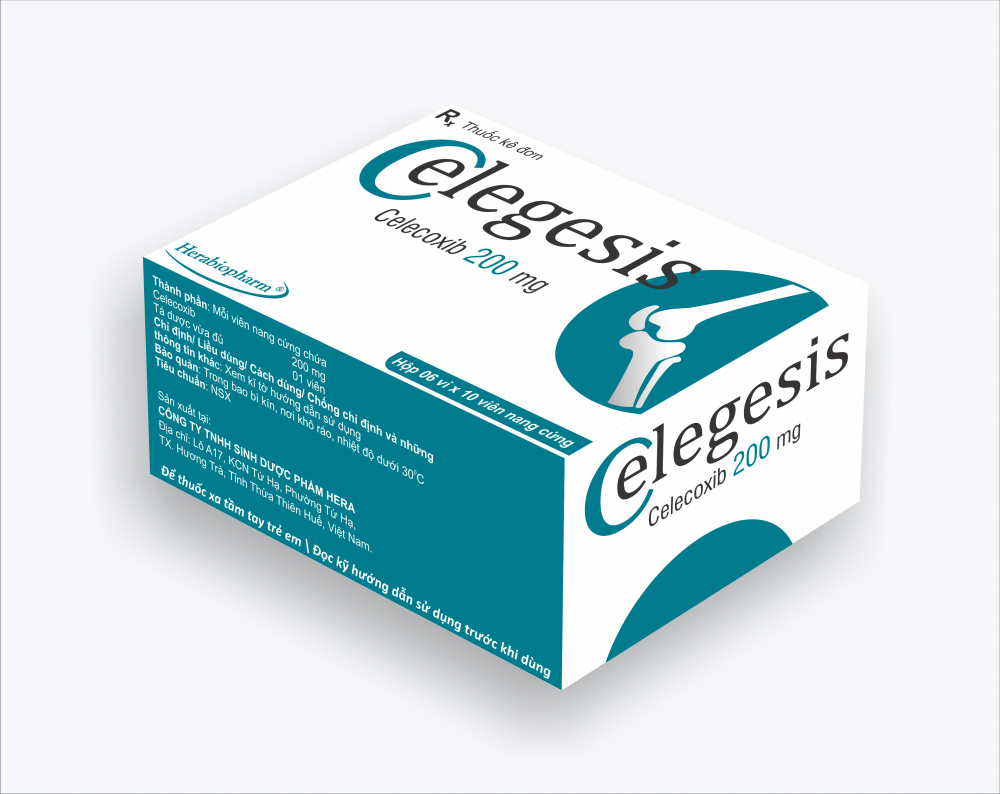CELEGESIS
- Packing6 blister packs of 10 capsules
- Shelf life36 months
- CompositionCelecoxib 200 mg
- Posology and pharmaceutical formHard capsule
Summary of product characteristic
-
Indications, posology and method of administration
THERAPEUTIC INDICATIONS
Celecoxib is indicated in adults for the symptomatic relief in the treatment of osteoarthritis (OA), rheumatoid arthritis (RA) and ankylosing spondylitis (AS).
The decision to prescribe a selective cyclooxygenase-2 (COX-2) inhibitor should be based on an assessment of the individual patient’s overall risks.
POSOLOGY AND METHOD OF ADMINISTRATION
Posology:
As the cardiovascular (CV) risks of celecoxib may increase with dose and duration of exposure, the shortest duration possible and the lowest effective daily dose should be used. The patient’s need for symptomatic relief and response to therapy should be re-evaluated periodically, especially in patients with osteoarthritis.
- Osteoarthritis:
The usual recommended daily dose is 200 mg taken once daily or in two divided doses. In some patients, with insufficient relief from symptoms, an increased dose of 200 mg twice daily may increase efficacy. In the absence of an increase in therapeutic benefit after two weeks, other therapeutic options should be considered.
- Rheumatoid arthritis:
The initial recommended daily dose is 200 mg taken in two divided doses. The dose may, if needed, later be increased to 200 mg twice daily. In the absence of an increase in therapeutic benefit after two weeks, other therapeutic options should be considered.
- Ankylosing spondylitis:
The recommended daily dose is 200 mg taken once daily or in two divided doses. In a few patients, with insufficient relief from symptoms, an increased dose of 400 mg once daily or in two divided doses may increase efficacy. In the absence of an increase in therapeutic benefit after two weeks, other therapeutic options should be considered.
The maximum recommended daily dose is 400 mg for all indications.
Special populations:
Elderly
As in younger adults, 200 mg per day should be used initially. The dose may, if needed, later be increased to 200 mg twice daily. Particular caution should be exercised in elderly with a body weight less than 50 kg.
Paediatric population
Celecoxib is not indicated for use in children.
CYP2C9 poor metabolisers
Patients who are known, or suspected to be CYP2C9 poor metabolisers based on genotyping or previous history/experience with other CYP2C9 substrates should be administered celecoxib with caution as the risk of dose-dependent adverse effects is increased. Consider reducing the dose to half the lowest recommended dose.
Hepatic impairment
Treatment should be initiated at half the recommended dose in patients with established moderate liver impairment with a serum albumin of 25 – 35 g/l. Experience in such patients is limited to cirrhotic patients.
Renal impairment
Experience with celecoxib in patients with mild or moderate renal impairment is limited, therefore such patients should be treated with caution.
Method of administration:
Oral use. Celecoxib may be taken with or without food. For patients who have difficulty swallowing capsules, the contents of a celecoxib capsule can be added to applesauce, rice gruel, yogurt or mashed banana. To do so, the entire capsule contents must be carefully emptied onto a level teaspoon of cool or room temperature applesauce, rice gruel, yogurt or mashed banana and should be ingested immediately with 240 ml of water.
CONTRAINDICATIONS
- Hypersensitivity to the active substance or to any of the excipients.
- Known hypersensitivity to sulfonamides.
- Active peptic ulceration or gastrointestinal (GI) bleeding.
- Patients who have experienced asthma, acute rhinitis, nasal polyps, angioneurotic oedema, urticaria or other allergic-type reactions after taking acetylsalicylic acid (aspirin) or other non-steroidal anti-inflammatory drugs (NSAIDs) including COX-2 inhibitors.
- In pregnancy and in women of childbearing potential unless using an effective method of contraception. Celecoxib has been shown to cause malformations in the two animal species studied. The potential for human risk in pregnancy is unknown, but cannot be excluded.
- Breast-feeding.
- Severe hepatic dysfunction (serum albumin < 25 g/l or Child-Pugh score ≥ 10).
- Patients with estimated creatinine clearance < 30 ml/min.
- Inflammatory bowel disease.
- Congestive heart failure (NYHA II-IV).
- Established ischaemic heart disease, peripheral arterial disease and/or cerebrovascular disease.
This information is for reference only. Please read the leaflet inside.
